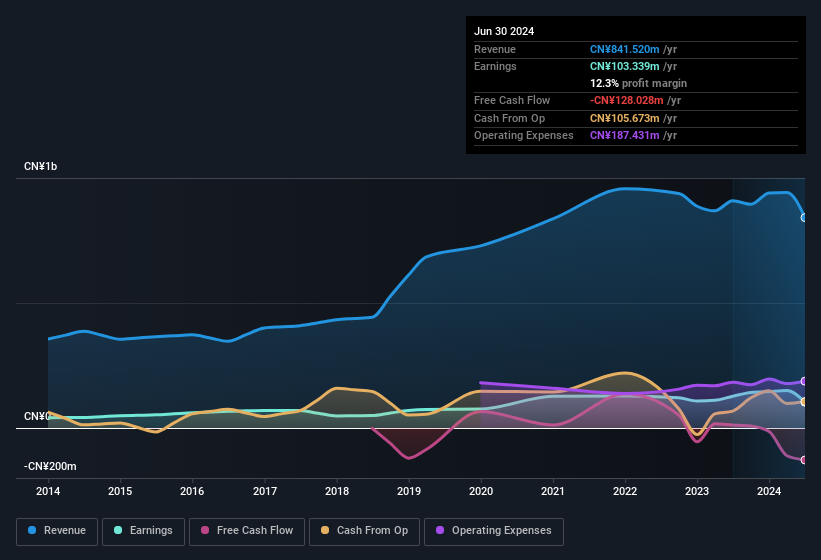Harbin Sayyas Windows' (SZSE:301227) Problems Go Beyond Weak Profit
Last week's earnings announcement from Harbin Sayyas Windows Co., Ltd. (SZSE:301227) was disappointing to investors, with a sluggish profit figure. We did some analysis, and found that there are some reasons to be cautious about the headline numbers.
See our latest analysis for Harbin Sayyas Windows

Zooming In On Harbin Sayyas Windows' Earnings
In high finance, the key ratio used to measure how well a company converts reported profits into free cash flow (FCF) is the accrual ratio (from cashflow). To get the accrual ratio we first subtract FCF from profit for a period, and then divide that number by the average operating assets for the period. This ratio tells us how much of a company's profit is not backed by free cashflow.
As a result, a negative accrual ratio is a positive for the company, and a positive accrual ratio is a negative. That is not intended to imply we should worry about a positive accrual ratio, but it's worth noting where the accrual ratio is rather high. Notably, there is some academic evidence that suggests that a high accrual ratio is a bad sign for near-term profits, generally speaking.
For the year to June 2024, Harbin Sayyas Windows had an accrual ratio of 0.22. We can therefore deduce that its free cash flow fell well short of covering its statutory profit. Even though it reported a profit of CN¥103.3m, a look at free cash flow indicates it actually burnt through CN¥128m in the last year. We saw that FCF was CN¥12m a year ago though, so Harbin Sayyas Windows has at least been able to generate positive FCF in the past. Having said that, there is more to the story. The accrual ratio is reflecting the impact of unusual items on statutory profit, at least in part.
That might leave you wondering what analysts are forecasting in terms of future profitability. Luckily, you can click here to see an interactive graph depicting future profitability, based on their estimates.
The Impact Of Unusual Items On Profit
The fact that the company had unusual items boosting profit by CN¥6.6m, in the last year, probably goes some way to explain why its accrual ratio was so weak. While it's always nice to have higher profit, a large contribution from unusual items sometimes dampens our enthusiasm. When we analysed the vast majority of listed companies worldwide, we found that significant unusual items are often not repeated. And, after all, that's exactly what the accounting terminology implies. Assuming those unusual items don't show up again in the current year, we'd thus expect profit to be weaker next year (in the absence of business growth, that is).
Our Take On Harbin Sayyas Windows' Profit Performance
Harbin Sayyas Windows had a weak accrual ratio, but its profit did receive a boost from unusual items. Considering all this we'd argue Harbin Sayyas Windows' profits probably give an overly generous impression of its sustainable level of profitability. If you want to do dive deeper into Harbin Sayyas Windows, you'd also look into what risks it is currently facing. For instance, we've identified 2 warning signs for Harbin Sayyas Windows (1 is potentially serious) you should be familiar with.
In this article we've looked at a number of factors that can impair the utility of profit numbers, and we've come away cautious. But there are plenty of other ways to inform your opinion of a company. Some people consider a high return on equity to be a good sign of a quality business. So you may wish to see this free collection of companies boasting high return on equity, or this list of stocks with high insider ownership.
Valuation is complex, but we're here to simplify it.
Discover if Harbin Sayyas Windows might be undervalued or overvalued with our detailed analysis, featuring fair value estimates, potential risks, dividends, insider trades, and its financial condition.
Access Free AnalysisHave feedback on this article? Concerned about the content? Get in touch with us directly. Alternatively, email editorial-team (at) simplywallst.com.
This article by Simply Wall St is general in nature. We provide commentary based on historical data and analyst forecasts only using an unbiased methodology and our articles are not intended to be financial advice. It does not constitute a recommendation to buy or sell any stock, and does not take account of your objectives, or your financial situation. We aim to bring you long-term focused analysis driven by fundamental data. Note that our analysis may not factor in the latest price-sensitive company announcements or qualitative material. Simply Wall St has no position in any stocks mentioned.
About SZSE:301227
Harbin Sayyas Windows
Manufactures and sells aluminum-clad wood air conditioning windows in China and internationally.
Excellent balance sheet with moderate growth potential.
Market Insights
Community Narratives



